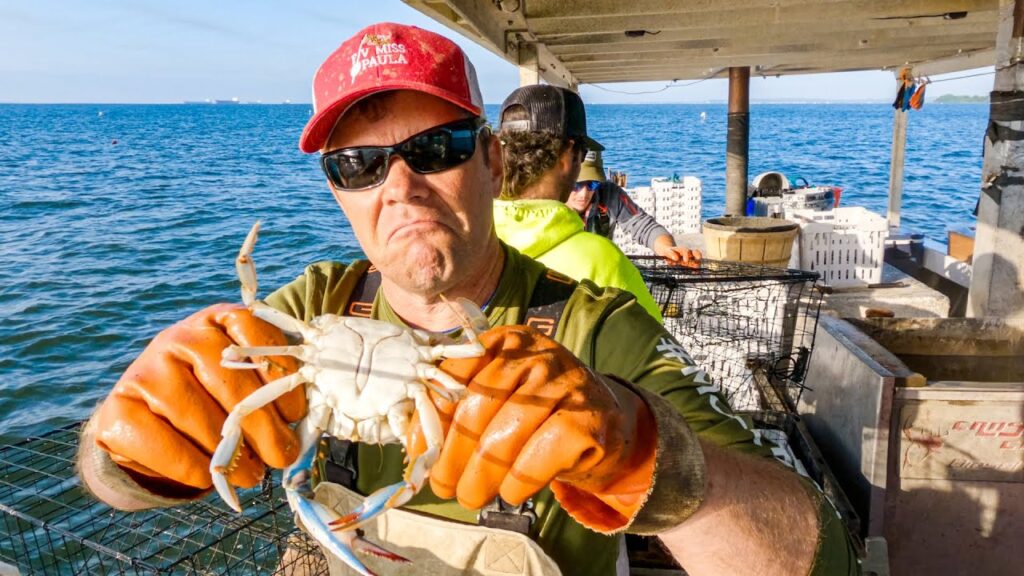“Maryland Crabbing and Bycatch 🦀🐟” is a captivating video that takes you on a journey with the fishing vessel Miss Paula as they engage in commercial crabbing in the Chesapeake Bay. The video highlights the use of underwater lines for crabbing and acknowledges the issue of bycatch, or unintentional catch, in the process. It also delves into the challenges faced by fishermen, such as social limits and potential early closures, as well as frustrations with political decision-making regarding crab limits. Throughout the video, you’ll witness encounters with stingrays, observation of dolphins, and even the catching of a snakehead fish, sparking a discussion about its impact on the ecosystem.
In this insightful video by FV Miss Paula, you’ll experience a day in the life of Maryland crabbers as they navigate the Chesapeake Bay. From the early start to the fishing conditions affected by weather and location below the bridge, the video provides a glimpse into the real challenges faced by fishermen. The mixed results of their crabbing efforts, encounters with marine wildlife, and the abundance of eggs in the snakehead fish all contribute to a captivating and educational viewing experience. Join FV Miss Paula on this adventure and discover the intricacies of Maryland crabbing and the importance of sustainable fishing practices.

Understanding Maryland Crabbing
Table of Contents
Maryland crabbing is a popular fishing activity in the Chesapeake Bay that involves capturing crabs for commercial purposes. It is a crucial part of the local economy and provides a livelihood for many individuals involved in the industry. The fishing vessel Miss Paula plays a significant role in Maryland crabbing, utilizing underwater lines to catch crabs effectively. However, the process of crabbing is not without its challenges, one of which is the occurrence of bycatch.
Bycatch in Maryland Crabbing
Bycatch refers to the unintended capture of non-targeted species while fishing or crabbing. In Maryland crabbing, several common species may end up being caught unintentionally. This can have serious implications for the ecosystem and the fishing industry as a whole. It is essential to understand the effects of bycatch and implement measures to minimize its occurrence.
Crabbing and Fishing on Miss Paula
On the fishing vessel Miss Paula, crabbing and fishing occur simultaneously. This unique aspect of crabbing on the vessel sets it apart from traditional crabbing methods. The incorporation of underwater lines in crabbing allows for efficient and productive fishing. The crew aboard Miss Paula has developed techniques and strategies to optimize their crabbing and fishing operations.
Environmental Influence on Maryland Crabbing
The success of Maryland crabbing is greatly influenced by various environmental factors. Weather conditions, such as wind and temperature, play a crucial role in the abundance and behavior of crabs in the Chesapeake Bay. Additionally, the location where fishing takes place can significantly impact the yield of crabs. While crabbing, the crew of Miss Paula also observes the diverse marine life found in the bay, including dolphins and other species.
Regulations Governing Maryland Crabbing
Maryland crabbing is subject to specific regulations to ensure the sustainability of the crab population and protect the ecosystem. These regulations include fishing limits in the Chesapeake Bay, which determine the quantity of crabs that can be harvested. There is ongoing discussion and potential early closures to address the challenges faced by the crabbing industry. However, frustration may arise due to political decision-making processes that impact these regulations.
Results of Maryland Crabbing
The results of Maryland crabbing can vary from day to day and even from pot to pot. Some pots may be loaded with crabs, while others may come up empty. The crew of Miss Paula has experienced both successful and challenging days while crabbing. Additionally, they often encounter stingrays during their crabbing ventures, raising the question of whether encountering stingrays is a common occurrence.
Discovery of a Snakehead Fish
During crabbing on Miss Paula, the crew had an unexpected encounter with a snakehead fish. The snakehead fish is known to have a significant impact on the Chesapeake Bay ecosystem. Observing the fish’s pregnancy cycle provided valuable insights into its reproductive behavior.
Understanding the Chesapeake Bay Ecosystem
Crabbing in the Chesapeake Bay is not only a means of livelihood but also has implications for the ecosystem. The presence of dolphins and other marine life in the bay indicates a healthy ecosystem. Understanding the food chain and the interactions between different species in the bay is vital for maintaining the delicate balance of the ecosystem.
Sustainable Practices in Maryland Crabbing
Sustainability is of utmost importance in Maryland crabbing. It is crucial to ensure the long-term viability of crab populations and minimize the impact on the ecosystem. One way to achieve this is by implementing sustainable fishing practices that minimize bycatch. Various initiatives are aimed at promoting responsible fishing methods and encouraging fishermen to adopt sustainable practices.
Conclusion
In conclusion, Maryland crabbing is a vital activity in the Chesapeake Bay, supporting the local economy and providing seafood for consumption. However, bycatch poses challenges to the industry and requires proactive measures to minimize its occurrence. The fishing vessel Miss Paula plays a significant role in Maryland crabbing, utilizing unique techniques to optimize crabbing and fishing operations. The environmental factors of weather and location greatly influence the success of crabbing, while regulations govern the industry to ensure sustainability. Maryland crabbing results can vary, and encounters with unexpected species like the snakehead fish provide valuable insights. Ensuring the sustainability of Maryland crabbing and adopting sustainable practices is crucial for the future of the industry. Further research and exploration are needed to better understand and address the challenges faced by Maryland crabbing.
